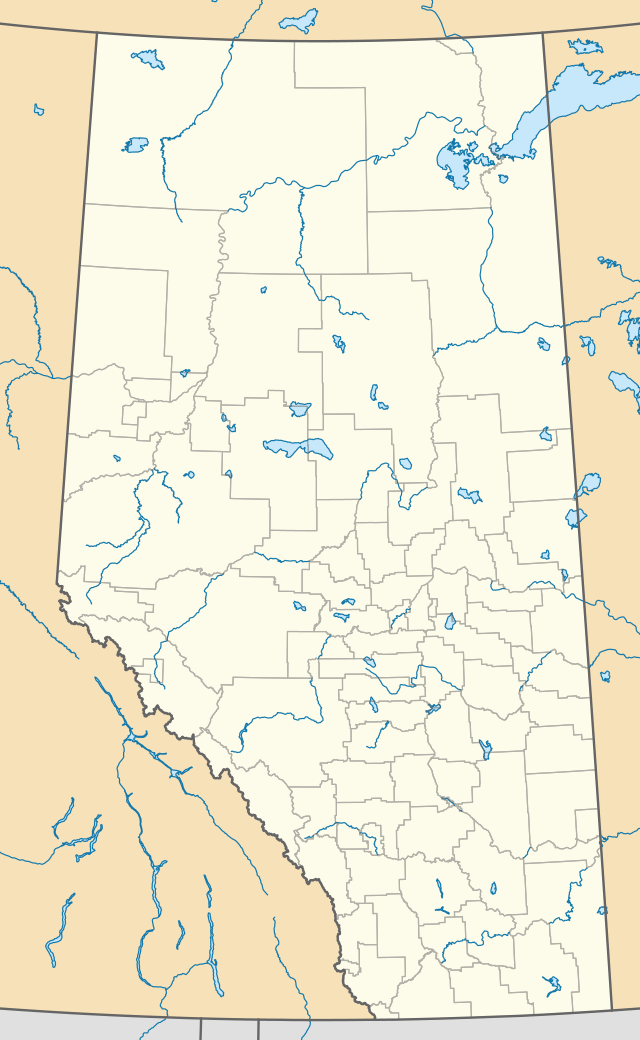Mount Blane (Alberta)
Mount Blane is a 2,993-metre (9,820-foot) mountain summit located in the Opal Range of the Canadian Rockies of Alberta, Canada.[3] Its nearest higher peak is Mount Jerram, 3.3 km (2.1 mi) to the southeast.[1]
| Mount Blane | |
|---|---|
 Mount Blane, west face shown | |
| Highest point | |
| Elevation | 2,993 m (9,820 ft) [1] |
| Prominence | 204 m (669 ft) [1] |
| Parent peak | Mount Jerram (2996 m)[1] |
| Listing | Mountains of Alberta |
| Coordinates | 50°43′35″N 115°04′22″W [1] |
| Geography | |
 Mount Blane Location of Mount Blane in Alberta  Mount Blane Mount Blane (Canada) | |
| Location | Alberta, Canada |
| Parent range | Opal Range[2] Canadian Rockies |
| Topo map | NTS 82J/11 |
| Geology | |
| Age of rock | Cambrian |
| Type of rock | Limestone |
| Climbing | |
| First ascent | 1955 by P.J.B. Duffy, G. Hohnson, D. Kennedy, F. Koch[1] |
History
The mountain was named in honor of Sir Charles Rodney Blane (1879–1916), Royal Navy commander of the battlecruiser HMS Queen Mary. He was killed during the Battle of Jutland when his ship exploded and sank.[4] The mountain's name was made official in 1922 by the Geographical Names Board of Canada.[3]
The first ascent of the peak was made in 1955 by P.J.B. Duffy, G. Hohnson, D. Kennedy, and F. Koch.[1] Koch perished during the descent.
Geology
Mount Blane is composed of sedimentary rock laid down during the Precambrian to Jurassic periods. Formed in shallow seas, this sedimentary rock was pushed east and over the top of younger rock during the Laramide orogeny.[5]
Climate
Based on the Köppen climate classification, Mount Blane is located in a subarctic climate zone with cold, snowy winters, and mild summers.[6] Temperatures can drop below −20 °C with wind chill factors below −30 °C.
In terms of favorable weather, June through September are the best months to climb Mount Blane.
Precipitation runoff from the west side of the mountain drains into the Kananaskis River, whereas the east side drains into tributaries of the Elbow River.
See also
References
- "Mount Blane". Bivouac.com. Retrieved 2018-11-28.
- "Opal Range". Peakbagger.com. Retrieved 2020-01-20.
- "Mount Blane". Geographical Names Data Base. Natural Resources Canada. Retrieved 2018-11-28.
- Place-names of Alberta. Ottawa: Geographic Board of Canada. 1928. p. 21.
- Gadd, Ben (2008). "Geology of the Rocky Mountains and Columbias". Missing or empty
|url=(help) - Peel, M. C.; Finlayson, B. L. & McMahon, T. A. (2007). "Updated world map of the Köppen−Geiger climate classification". Hydrol. Earth Syst. Sci. 11: 1633–1644. ISSN 1027-5606.
External links

- Charles Blane Sir Charles R. Blane
- Mount Blane weather: Mountain Forecast